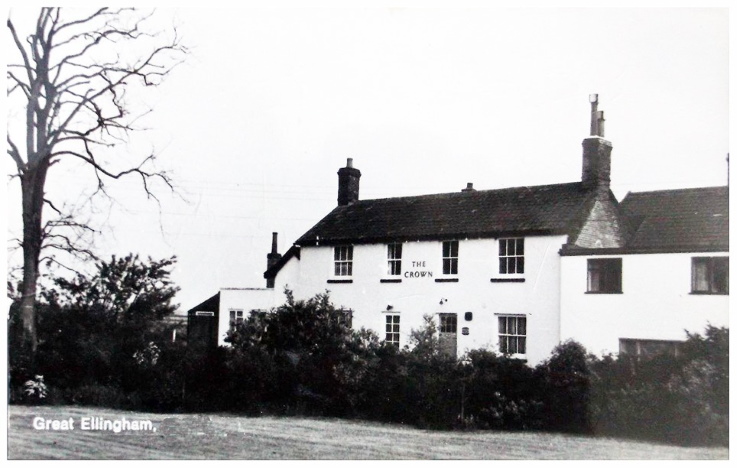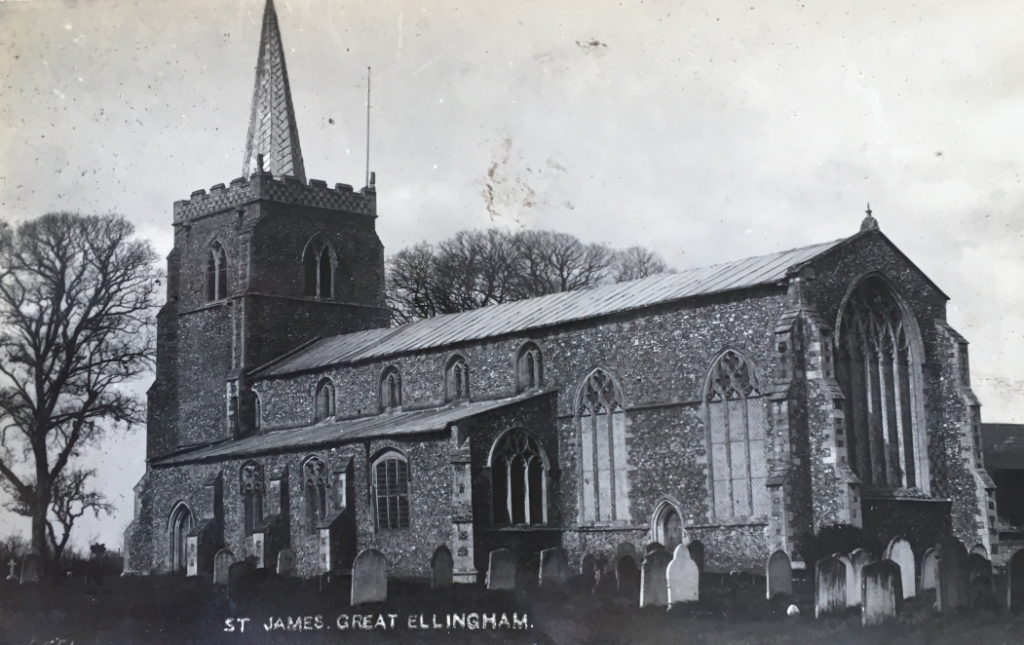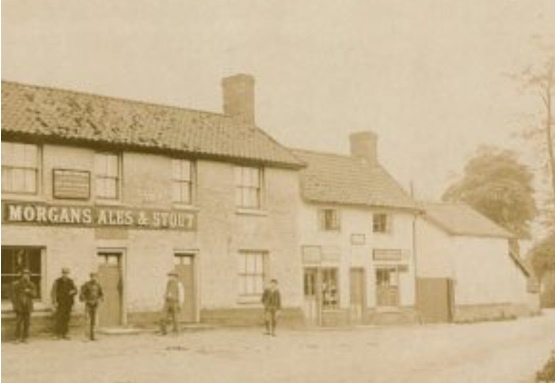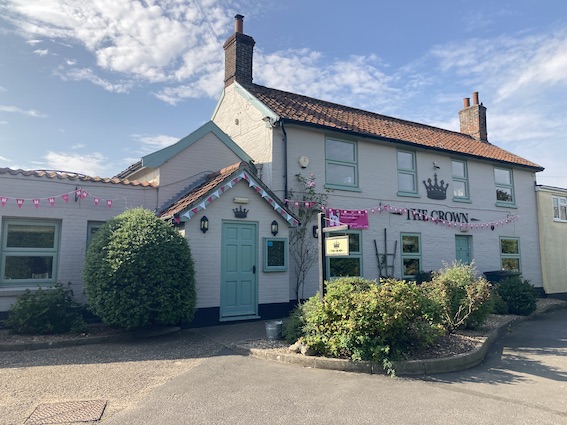
The Crown Public House possible 1960s. Courtesy Tony Brooks
The Crown in Church Street is one of at least five pubs and beer houses which were once in Great Ellingham. However, it is now the only surviving public house in the village.
The origins of the pub go back over 200 years. The first mention I have found in deeds of an inn or public house on this site in Church Street, is in a Conveyance Deed of 1784. The inn was called ‘The Bell’. However, there is evidence of The Bell earlier than 1784. In 1781, a local newspaper refers to a meeting of landowners held at The Bell in Great Ellingham.
By 1787, the pub is referred to as The Crown. By the turn of the 19th century, it is the Rose & Crown. However at some point after 1819, the name reverted back to The Crown. Nevertheless, locals may have dropped ‘the Rose’ from the ‘Rose & Crown’ earlier than this.
Early History
Part I began at 1732 with the earliest known history (so far!) of the property. It concludes with the fire in 1787 which, it is said, consumed The Crown as well as Widow Caddy’s home.
We continued Part II in 1784 when Richard Leath, farmer of Little Ellingham, agrees with Jeffrey Warren to purchase the public house and the nearby cottages. Part II ends in 1810 with the sale by Benjamin Dennis to John Robert Barnard, and the subsequent death of Alice Jessup, the former Alice Clarke who was once married to Richard Leath.
In this article, we take the ownership of the property forward at least another century.
John Robert Barnard’s Purchase
On the 23rd November, 1810, carpenter, John Robert Barnard purchased The Crown Inn (together with nearby properties and land) from Benjamin and Frances Dennis. Evidence conflicts as to whether the property is then known as The Crown or the Rose & Crown. In any event, I believe that Barnard was already the landlord of the pub at the time of his purchase.
For the price of £680, Barnard purchased four messuages, three cottages, two stables, four gardens and two acres.
This included:
- The premises known as The Crown
- Two small tenements or cottages near to The Crown, which had once been occupied by Edward Steele and Robert Tooke and then by __________ Kerrison and Hannah Steel
- A small piece of ground
- The site of a messuage or tenement with yard which, much earlier, was occupied by Isaac Meek, but had since been destroyed by fire
John Robert Barnard purchased The Crown and the other properties with the help of a mortgage of £500 from beer brewer, John Stephenson Cann of Wymondham.
However, it did not include the house adjoining the western side of The Crown. Benjamin Dennis retained this property but gave Barnard a right to enter through the garden of this house together with ladders and any necessary tools etc in order for Barnard to maintain The Crown. As it happens, in 1819 Benjamin Dennis sold this adjoining property to local shopkeeper William Rose.
John Robert Barnard
A son of Charles Barnard and his wife Mary nèe Cushing, John Robert Barnard was born and baptised in Hingham in the February of 1785. At that time, George III had been on the throne for some 25 years.
John Robert’s father, Charles Barnard, owned The Chequers Inn, Great Ellingham before his untimely death in 1796. However, John Robert’s mother, Mary, continued to run The Chequers with her second husband, William Warren, until her death in 1808.
Whilst Charles Barnard left a life tenancy in The Chequers to his widow Mary, ultimately the ownership of The Chequers passed to his three children – Charles William Barnard, John Robert Barnard and Ann Elizabeth Chaplin. However, I am uncertain as to whether John Robert Barnard actually became a legal owner of The Chequers.

Courtesy Attleborough Heritage Group
Nevertheless, it was two years after his mother’s death that in November 1810, John Robert Barnard purchased The Crown. It was also only a month after his marriage in St James’s Church to local girl, Lydia Yeomans.
A survey of Great Ellingham dated 1817-1819, shows ‘John Robert Barnard (son of Charles Barnard)’ as the owner of the Rose & Crown Public House, a cottage, yard and pightle.
Barnard occupied the Rose & Crown, and his tenants were the widow Clarke and James Webster.
Children
Whilst living at The Crown (or perhaps it was then Rose & Crown), John Robert Barnard’s wife gave birth to eight known children. Most likely, John Barnard also continued with his ‘day job’ as a carpenter.
Elizabeth was born in 1811 with Robert John in 1814. Hannah arrived in 1816 but sadly survived only one week. Another daughter named Hannah arrived in 1817 with James following in 1821, Harriet in 1822, Charles in 1824 and, finally, George in 1827.
Rose & Crown to The Crown
Moving into the 1830s, the property is still known as the Rose & Crown. However, White’s Directory of 1836 lists the property as The Crown.
Death of John Robert Barnard
At the age of 50, John Robert Barnard died in the April of 1834. He was buried in the churchyard of St James on the 9th April. Widowed with four of her seven surviving children aged 13 and under, Lydia continued to run the public house.
John Robert Barnard died intestate – he did not leave a will. Accordingly, we can only wonder whether his death was sudden and unexpected.
The mortgage to John Stephenson Cann was still outstanding. However, John Stephenson Cann died in 1813 and, subsequently, the debt transferred to his son, William Robert Cann. Nevertheless, Cann may well have transferred the debt to Edward Palmer Clarke.
In any event, it seems that the interest payments on the loan were being made.
1841 census
The census of 1841 captures Lydia Barnard as a Publican at the Crown Inn. With her are some of her children.
At 21, Hannah is working as a dressmaker. 15 year old James is a carpenter – the very same occupation of his late father. George aged 13 is working as a tailor. Possibly living nearby is Lydia’s father, Jonathan Yeomans and Thomas Beales. Both men are in their seventies.
1843 Tithe Map
Great Ellingham’s Tithe Map of the 16th December, 1843, lists Lydia Barnard as the owner and occupier of the public house and premises in Church Street. She is also ‘occupying’ a nearby pightle of around two acres.
Son Robert John Barnard
It was probably after 1843 that Lydia’s son, Robert John Barnard, became the landlord of The Crown. He had married Sarah Miller in East Harling on the 3rd January, 1839. The couple had two children, Emma and Isaac, born and baptised in East Harling between 1840 and 1843.
However, compared to his parents’ time at The Crown, Robert’s tenure is relatively short. It may be that the Barnard family were under some pressure from their lender to repay the outstanding debt of £500.
1845 Auction
The Norwich Mercury of Saturday, 13th September, 1845 includes a notice “To Brewers” of the forthcoming Auction by George W Salter of the Leys, Attleburgh. The Auction would take place at The Crown Inn, Great Ellingham on Monday the 22nd September at six o’clock in the evening.
The freehold premises (sold in one lot) comprised a “convenient and well-situated and old established free public house called the Crown Inn” together with stables, other outbuildings and two roods of garden ground.
In addition, an adjoining double tenement would be sold. All the premises were in the occupation of Mrs L Barnard and her under-tenants.
The ‘adjoining double tenement‘ mentioned is not the house which adjoins the western side of The Crown. At this time, this house is owned by the Rose family.
1849 Sale to Clarke & Cann
I do not believe the premises sold at the auction. Indeed, it may be the case that Robert John Barnard continued to run The Crown until he reached an agreement with Clarke and Cann to sell the premises to them.
On the 9th October, 1849, Barnard (described as a victualler of Great Ellingham), sold The Crown and the nearby property to William Robert Clarke and William Robert Cann, both of Wymondham.
The total purchase price was £693. This comprised the sum of £193 and the repayment of the £500 outstanding principal debt which Robert’s father had borrowed against the property in 1810. Robert Barnard received £193 from Clarke and Cann. Cann and Clarke also paid £500 to Edward Palmer Clarke in discharge of the principal debt.
Accordingly, Clarke and Cann became the owners of:
- The Crown which is said to have been occupied by William & Alice Jessup and afterwards by Benjamin Dennis and then John Robert Barnard, afterwards Lydia Barnard and then Robert John Barnard
- Two cottages near The Crown formerly occupied by Edward Steel and Robert Tooke, afterwards of ______ Kerrison and Hannah Steele and more lately occupied by Edward Kerrison and _____ Carter
- A piece of ground of around two acres formerly occupied by Alice Jessup and afterwards by Benjamin Dennis
- The site of a messuage or tenement with the yard formerly occupied by Isaac Meek which ‘was many years since destroyed by fire’
Cann and Clarke also had the benefit of the right of way through the garden of the adjoining property (to the west) which had once been occupied by Edward Steel, afterwards by Benjamin Dennis and then or lately by _________Twidney.
Wymondham Brewery
William Robert Cann and William Robert Clarke were partners. They were part of the Wymondham Brewery. Accordingly, The Crown was then run by a tenant landlord.
In 1841, blacksmith Robert Lebbell was the landlord of The Chequers Inn in Great Ellingham. However by 1851, Robert Lebbell is landlord of The Crown. He remained as licensee until his death in 1885.
Auction of Wymondham Brewery
The Norwich Mercury of the 21st August, 1872, reports that Wymondham Brewery together with 42 public houses were to be offered for sale at an auction held at the Rampant Horse Inn, Norwich on the 21st September, 1872. The premises included The Crown in Great Ellingham.
However, it appears that the auction did not proceed. The following notice is published in the Norwich Mercury of the 31st August, 1872:
WYMONDHAM BREWERY
Messrs Spelman are instructed to announce that in consequence of the unsettled state of the law affecting property of this description, occasioned by the 'Licensing Act, 1872' , the sale of the BREWERY PUBLIC HOUSE &c, advertised to take place on Saturday, the 21st of September next, IS POSTPONED FOR THE PRESENT
Notwithstanding the above, I have no doubt that Wymondham Brewery continued to own The Crown. In 1876, the legal title to the Wymondham Brewery and most (if not all) of the 42 public houses were conveyed to William Cann and Elijah Crosier Bailey under the will of the late William Robert Cann. I have not yet investigated the document relating to this transaction. [Norfolk Record Office. Catalogue Ref BR 157/11]
During this time, Robert Lebbell continued as landlord of The Crown.
Landlords, Robert Lebbell and Charles William Barnard
Lebbell was landlord from at least 1851 until his death in 1885. From at least 1891 until 1896, The Crown’s landlord was Charles William Barnard.
Morgans Brewery

The Crown at the time of Morgans Brewery ownership. Postcard courtesy Carol Ewin
According to Norfolk Pubs website, on the 11th May, 1894, the Wymondham Brewery (and presumably all of its public houses including The Crown), was conveyed to Morgans Brewery of Norwich, for the sum of £129,000.
Morgans Brewery went into voluntary liquidation on the 29th September, 1961. Their public houses were taken over jointly by Bullards and Steward & Patteson, the latter taking over the ownership of The Crown.
Watney Mann had acquired the Brewery during the preceding month.
Further Landlords
The Crown had at least 13 further landlords between 1901 and 1979. The building and the surrounding land will have undergone many changes over the years.
Today, there is no evidence of the additional cottages which were once the homes of Isaac Meek, William & Elizabeth Cady, Edward Kerrison and Robert Tooke, as well as many others.

The present day Crown Public House is a freehouse, and is still very much at the heart of the community.
Sources:
Abstract of Title to the Crown Public House, Great Ellingham. Original held at Wymondham Town Archive, Council Offices, Ketts Park, Harts Farm Road, Wymondham, Norfolk, NR18 0UT. ID. 33827, Pomeroy Collection, Box 116/99. Bundle 8. 23/11/1810
Private Collection Title Deeds. Sue Simpson
Private Collection Title Deeds. Shirley Caston
1802 Russell James Colman Plans. Great Ellingham. Norfolk Record Office. Catalogue Ref. C/Ca 1/84.
1799-1842 F W Horner, Records of the Surveyors to Commissioners for Inclosure in Parishes in Norfolk and Suffolk. Great Ellingham (Act 1799). Norfolk Record Office. Catalogue Ref: NRO, BR 90/2
1800 Inclosure Commissioner’s Particulars and Valuation, Great Ellingham. Norfolk Record Office. Catalogue Ref: NRO, MC 2213/119
1799 Statement of Claims. Great Ellingham Inclosure. Norfolk Record Office. Catalogue Ref: MC 2213/118
Great Ellingham Tithe Map 1843. Tithe Apportionments, 1836-1929 [database online]. TheGenealogist.co.uk 2023. Original data: “IR29 Tithe Commission and successors: Tithe Apportionments” The National Archives
Norfolk Pubs Website
Great Ellingham Parish Registers. Norfolk Record Office PD 609.
Hingham Parish Registers. Norfolk Record Office. PD 575.
East Harling Parish Registers. Norfolk Record Office. PD 219.
Also available at www.familysearch.org www.ancestry.co.uk and other online platforms
1836 White’s Directory. Norfolk Record Office
1841 census HO107/781/8
1851 census HO107/1823/109 & HO107/1822/332
13th September, 1845. Norwich Mercury
21st August, 1872. Norwich Mercury
31st August, 1872. Norwich Mercury
Newspapers viewed via The British Newspaper Archive